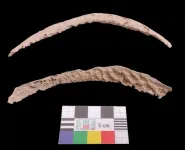(Press-News.org) Research from Radboud university medical center shows that the lockdowns during the COVID-19 pandemic had a significant impact on people's immune response to microorganisms. During the lockdown, inflammation level in the body was low, but afterwards, the immune system reacted more intensely to viruses and bacteria. The results are now published in Frontiers of Immunology.
In this study, the researchers examined the effects of various health measures introduced during the pandemic, such as lockdowns and vaccinations. The study was conducted in a large cohort of people living with HIV, as well as in healthy individuals. The researchers found that inflammation biomarkers in the blood were low during the lockdown for people in both groups. However, when they exposed immune cells from the blood to microorganisms like viruses and bacteria in the lab, the immune system reacted much stronger than immune cells of individuals outside the lockdown.
Hygiene Hypothesis
As a possible explanation for this strong immune reaction, Professor Mihai Netea from Radboud university medical center points to the hygiene hypothesis. This hypothesis suggests that regular contact with microorganisms is beneficial because it keeps the immune system both active and tolerant at the same time. A lack of exposure to environmental factors might contribute to an immune system that overreacts, potentially leading to systemic reactions such as those encountered in inflammatory diseases and allergies.
Netea: 'In our daily lives, we are constantly exposed to various micro-organisms. This helps train our immune system, teaching it to recognize which microorganisms are dangerous and which are harmless. During the lockdown, we missed that interaction because everyone stayed home and avoided each other. As a result, during and immediately after the lockdown periods, immune cells exposed to micro-organisms displayed a less well-regulated response, predisposing to hyperinflammation.'
Study Design
This research was made possible through a large study on people with HIV, initiated by Radboudumc and three other HIV treatment centers in the Netherlands. Recruitment for the study took place between October 2019, just before the COVID-19 pandemic, and October 2021. A total of 1,895 people with HIV are participating in this study, which is part of a broader research project on immune system function and the diversity of immune responses.
The study participants were divided into four groups:
368 individuals enrolled before the pandemic
851 individuals enrolled after the lockdown, but before vaccination or a COVID-19 infection
175 individuals who had contracted a COVID-19 infection
404 vaccinated individuals
In the lab, the researchers measured the level of inflammation in the participants' blood. They also examined the interaction between isolated blood cells and viruses and bacteria.
Subsequently, the findings were validated in cohort of 30 healthy individuals tested during or after the lockdown period. Professor Andre van der Ven: 'The results of this study primarily reflect people living with HIV, but we also examined a healthy control group. We saw similar results in this group, suggesting the effects may apply to the wider population. However, more research is needed for this group.'
Awareness of Impact
The study also revealed that vaccines and a COVID-19 infection influenced the immune system’s response, but these effects were relatively small and short-lived, Netea explained, and were negligible compared to the impact of the lockdowns on the immune system. Netea: 'Lockdowns were necessary during the pandemic, especially at the beginning. However, it is important that we gain more insight into how social interactions affect and activate our immune system, so we can better manage the consequences. This way, we can apply such drastic social measures effectively and safely in a future pandemic.'
END
After lockdown, immune system reacts more strongly to viruses and bacteria
Comparison of the immune system in people with HIV and a control group
2024-12-18
ELSE PRESS RELEASES FROM THIS DATE:
MD Anderson Research Highlights for December 18, 2024
2024-12-18
HOUSTON ― The University of Texas MD Anderson Cancer Center’s Research Highlights showcases the latest breakthroughs in cancer care, research and prevention. These advances are made possible through seamless collaboration between MD Anderson’s world-leading clinicians and scientists, bringing discoveries from the lab to the clinic and back.
Smoking cessation medications are safe and effective for people with depression
Individuals with major depressive disorder (MDD) are more likely to smoke, leading to higher risks of nicotine addiction and early death from tobacco-related illnesses. To identify the best treatments for quitting, researchers led by George ...
Massive black hole in the early universe spotted taking a ‘nap’ after overeating
2024-12-18
Scientists have spotted a massive black hole in the early universe that is ‘napping’ after stuffing itself with too much food.
Like a bear gorging itself on salmon before hibernating for the winter, or a much-needed nap after Christmas dinner, this black hole has overeaten to the point that it is lying dormant in its host galaxy.
An international team of astronomers, led by the University of Cambridge, used the NASA/ESA/CSA James Webb Space Telescope to detect this black hole in the early universe, just 800 million years after the Big Bang.
The black hole is huge – ...
Blight or benefit: how cellular neighbors shape the aging brain
2024-12-18
Much like plants in a thriving forest, certain cells in the brain create a nurturing environment, enhancing the health and resilience of their neighbors, while others promote stress and damage, akin to a noxious weed in an ecosystem.
A new study published in Nature on December 18, 2024, reveals these interactions playing out across the lifespan. It suggests local cellular interactions may profoundly influence brain aging — and offers fresh insights into how we might slow or even reverse the process.
“What was exciting to us was finding that some cells have a pro-aging effect on neighboring cells while others appear to have a rejuvenating effect on their neighbors,” ...
MIT engineers grow “high-rise” 3D chips
2024-12-18
The electronics industry is approaching a limit to the number of transistors that can be packed onto the surface of a computer chip. So, chip manufacturers are looking to build up rather than out.
Instead of squeezing ever-smaller transistors onto a single surface, the industry is aiming to stack multiple surfaces of transistors and semiconducting elements — akin to turning a ranch house into a high-rise. Such multilayered chips could handle exponentially more data and carry out many more complex functions than today’s electronics.
A significant hurdle, however, is the platform on which chips are built. Today, bulky ...
Physicists magnetize a material with light
2024-12-18
MIT physicists have created a new and long-lasting magnetic state in a material, using only light.
In a study that will appear in Nature, the researchers report using a terahertz laser — a light source that oscillates more than a trillion times per second — to directly stimulate atoms in an antiferromagnetic material. The laser’s oscillations are tuned to the natural vibrations among the material’s atoms, in a way that shifts the balance of atomic spins toward a new magnetic state.
The results provide a new way to control and switch antiferromagnetic materials, which are of interest for their potential ...
Unionization efforts by physicians between 2000 and 2024
2024-12-18
About The Study: Compared with 2000-2022, the number of union petitions with physicians in the bargaining units filed and certified increased in 2023 through May 2024. Organizing efforts were motivated by concerns about working conditions, physicians’ autonomy, and voice in management, and the quality of patient care.
Corresponding Author: To contact the corresponding author, Kevin Schulman, MD, email kevin.schulman@stanford.edu.
To access the embargoed study: Visit our For The Media website at ...
2024 update of the RECOVER-adult long COVID research index
2024-12-18
About The Study: The 2024 long COVID research index for adults builds on the 2023 index with additional data and symptoms to help researchers classify symptomatic long COVID and its symptom subtypes. Continued future refinement of the index will be needed as the understanding of long COVID evolves.
Corresponding Author: To contact the corresponding author, Leora I. Horwitz, MD, MHS, email leora.horwitz@nyulangone.org.
To access the embargoed study: Visit our For The Media website at this link https://media.jamanetwork.com/
(doi:10.1001/jama.2024.24184)
Editor’s Note: Please see the article for additional information, including ...
Building a backbone: scientists recreate the body’s ‘GPS system’ in the lab
2024-12-18
Scientists at the Francis Crick Institute have generated human stem cell models1 which, for the first time, contain notochord – a tissue in the developing embryo that acts like a navigation system, directing cells where to build the spine and nervous system (the trunk).
The work, published today in Nature, marks a significant step forward in our ability to study how the human body takes shape during early development.
The notochord, a rod-shaped tissue, is a crucial part of the scaffold of the developing body. ...
Syphilis had its roots in the Americas
2024-12-18
In spring 1495, the Italian campaign of Charles VIII of France was interrupted by an intense outbreak of an apparently unknown illness – a disease of high mortality that quickly engulfed the whole of Europe and left its survivors with life changing impairments to their bodies and minds. This documented epidemic is now interpreted to be the first historical account of syphilis.
The origin of syphilis is the subject of a decades-long debate. The late 15th century outbreak occurred shortly after the return of Columbus and his crew from their early expeditions to the Americas, which led some to believe that ...
Trajectory of cardiovascular health across childhood and adolescence
2024-12-18
About The Study: In this cohort of 1,500 children, across demographic subgroups, the trajectory of cardiovascular health (CVH) scores began to decline at approximately age 10, associated with health behaviors rather than health factors. Statistically significant (albeit small) differences in CVH trajectory parameters by sociodemographic characteristics were also identified. This study provides insight into the trajectory of CVH early in life, which may contribute to CVH disparities in adulthood, and identified modifiable ...
LAST 30 PRESS RELEASES:
Scalable and healable gradient textiles for multi‑scenario radiative cooling via bicomponent blow spinning
Research shows informed traders never let a good climate crisis go to waste
Intelligent XGBoost framework enhances asphalt pavement skid resistance assessment
Dual-function biomaterials for postoperative osteosarcoma: Tumor suppression and bone regeneration
New framework reveals where transport emissions concentrate in Singapore
NTP-enhanced lattice oxygen activation in Ce-Co catalysts for low-temperature soot combustion
Synergistic interface engineering in Cu-Zn-Ce catalysts for efficient CO2 hydrogenation to methanol
COVID-19 leaves a lasting mark on the human brain
Scientists use ultrasound to soften and treat cancer tumors without damaging healthy tissue
Community swimming program for Black youth boosts skills, sense of belonging, study finds
Specific depressive symptoms in midlife linked to increased dementia risk
An ‘illuminating’ design sheds light on cholesterol
Who is more likely to get long COVID?
Study showcases resilience and rapid growth of “living rocks”
Naval Research Lab diver earns Office of Naval Research 2025 Sailor of the Year
New Mayo-led study establishes practical definition for rapidly progressive dementia
Fossil fuel industry’s “climate false solutions” reinforce its power and aggravate environmental injustice
Researchers reveal bias in a widely used measure of algorithm performance
Alcohol causes cancer. A study from IOCB Prague confirms damage to DNA and shows how cells defend against it
Hidden viruses in wastewater treatment may shape public health risks, study finds
Unlock the power of nature: how biomass can transform climate mitigation
Biochar reshapes hidden soil microbes that capture carbon dioxide in farmland
Reducing saturated fat intake shows mortality benefit, but only in high-risk individuals
Manta rays create mobile ecosystems, study finds
Study: Mixed results in using lipoic acid to treat progressive multiple sclerosis
Norbert Holtkamp appointed director of Fermi National Accelerator Laboratory
New agentic AI platform accelerates advanced optics design
Biologists discover neurons use physical signals — not electricity — to stabilize communication
Researchers discover that a hormone can access the brain by hitchhiking
University of Oklahoma researcher awarded funding to pursue AI-powered material design
[Press-News.org] After lockdown, immune system reacts more strongly to viruses and bacteriaComparison of the immune system in people with HIV and a control group



